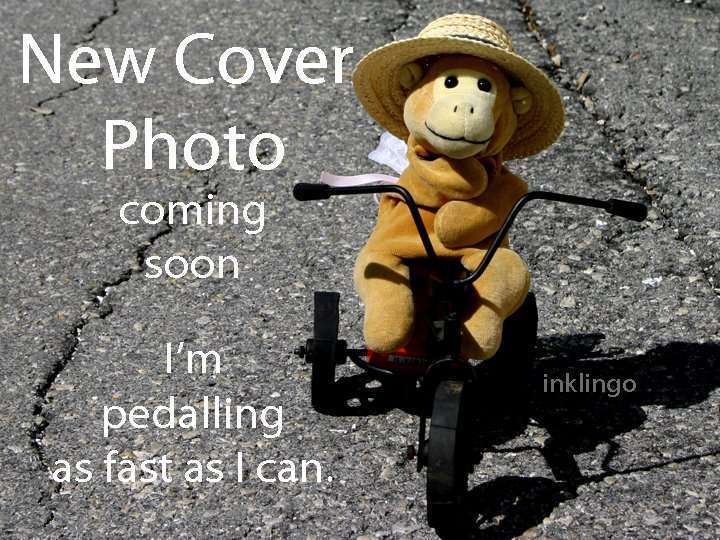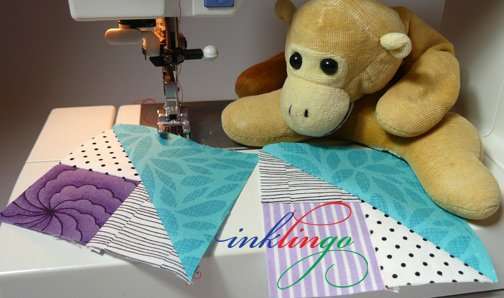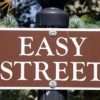Bonnie Hunter’s Easy Street Mystery Clue # 3 requires 64 Shaded 4 Patch blocks.
This versatile block is sometimes called by other names, like Birds in the Air.
My favorite method for Birds in the Air is included in The Inklingo Handbook.
These blocks just fall together when the triangles are printed on the fabric. This is a really fun method to learn and there is minimal printing.
Inklingo has big advantages compared to every other method:
- no special rulers with special instructions
- no math
- no measuring to cut fabric into strips, rectangles or triangles
- no triangles to cut—none!
- no stretchy bias seams to sew
- no need to draw lines on fabric
- no wasted fabric
- no squaring up or trimming at the end—a dangerous extra step
This block is fast and easy to machine piece, but you can even sew these units by hand if you need a portable project!
Inklingo makes it easy to get perfect blocks in less time.
I think you might be surprised by how little printing there is this time, and how accurate your blocks will be!
- Just print the little triangles (HST). You need 128 for Easy Street.
You can print 32 at a time, so only 4 sheets of fabric are printed!
I don’t think there is any advantage to printing the squares and large triangles, but you can print them if you want to. - You can use scraps or yardage.
Print on scraps as small as 2 x 3, if you need to. See the Top Ten Tutes for tips. - There is straight grain in all the right places.
- The bias seams are sewn before they are cut, so precision is easier.
- You can chain piece and use a scant 0.25 inch seam allowance, as usual.
- Each step presses perfectly.
- The blocks are the correct size without trimming off slivers at the end.
Read on for our best step-by-step method!
STEP BY STEP
Requirements for our Easy Street Mystery example:
When you know the finished size, Inklingo eliminates all of the math and measuring!
- The finished sizes—provided by Bonnie, as always.
- Squares 1.5 inch (2 inches unfinished)
- HST 1.5 inch
- HST 3 inch
- Any Inklingo shape collection which includes 1.5 inch HST
(There are several listed in the Index of Shapes.) - freezer paper
- fabric scraps, as described by Bonnie
- ordinary Inkjet printer
- sewing machine, scissors or rotary cutter, thread, etc.
1. ROTARY CUT THE SQUARES
Rotary cut 64 2-inch squares from a variety of purple scraps. You can cut several layers at a time, so this goes fast.
I don’t print the squares because this size is so easy to measure, cut, and sew. You could print 1.5 inch squares (finished size) on fabric if you prefer. This size is in several shape collections.
2 PRINT THE SMALL HST
Print 128 HST 1.5 inch (finished size) from a variety of black-on-white scraps. Cut rows, stack the rows, and cut the pairs of triangles apart, so you have rectangles as shown.
Important: Use the Inklingo layout with the HST laid out in rectangles, not the layout with the HST laid out in squares! Inklingo often gives you a choice of layouts. For the Flying Geese in Clue # 2, we needed the HST laid out in squares.
It is easiest to print 4 sheets of fabric with 32 HST each (Freezer paper 8.5 x 11.75 inches), and that is what I did. However, if you are working with smaller scraps or strips, or if you want to use more than 4 fabrics, there are smaller Suggested Custom Page Sizes listed too.
3. ASSEMBLY—TWO BLOCKS AT A TIME!
Before you start a chain piecing marathon, make one and measure to be sure you are sewing correct seam allowances. As usual, we use a scant 0.25 inch seam allowance, which means you sew immediately beside the stitching line, not on it.
a. Sew a purple square to each rectangle.
Press away from the square. Sort identical units into two piles. Identical units have the diagonal line going the same way. One pile has the diagonal line going one way, and one pile has it going the other, as shown.
b. Sew any 2 identical units, together.
The diagonal line is continuous when the unit is pressed. Clip the seam allowance near the middle of the seam, so you can press away from both squares. (It doesn’t matter if you nick the stitching when you clip.)
c. Layer the new unit with a turquoise rectangle.
The turquoise rectangle is the same size as the triangle unit. You can use a rotary cutter to trim the turquoise fabric to the same size.
In this case, if you prefer to measure, the rectangle is 3.5 x 4.125. (4 1/8)
Note: 3.5 is the unfinished size of the blocks and the other measurement is the unfinished size of the blocks plus 7/8 (or 0.875).
d. Sew beside both diagonal lines for scant 0.25 inch seams.
Be careful not to blunt the points of the squares. Cut on the solid diagonal line. Press toward the large triangle.
Before you continue with a chain piecing extravaganza, measure your first two blocks to be sure they are 3.5 x 3.5 inches (3 inches finished).
If they are too large or too small, you will need to sew closer to the stitching line or farther from the stitching line to perfect your scant 0.25 inch seam.
4. CHAIN PIECE STEPS a TO d AGAIN.
Repeat another 31 times to complete 64 Shaded 4 Patch Blocks.
Additional Tips
Notice how the diagonal lines of the HST line up with each other.
As long as both of the units are identical, you can sew them so the diagonal line runs across the whole piece, but you must sew them together along the correct edge.
Use a scant 0.25 inch seam allowance, immediately beside the stitching line in the seam allowance, as shown.
Now you can unleash the chain piecing demon in you! Repeat until you have stitched, pressed and sewn your way to 64 lovely Shaded 4 patches!
Unlimited Possibilities When You Print
When you have the lines accurately printed on the fabric with Inklingo, anything is possible! There are many more techniques like this which are faster and more accurate than traditional methods.
When you understand how simple and fast it is to print shapes on fabric, you can do anything, no matter how simple or complex the shapes. The sky is the limit. Your first shapes are free (below), so why not print today?
There is also a free Triangle Tips PDF under the Machine Piecing tab on the website.
I wanted to post this sooner, but last week was filled with very long dentist appointments followed by a yucky head cold. I am sure I caught the cold at the dentist’s. It’s been years and years since I had one, so I guess I can’t complain too much. More dental work to come. Oh, dear. Choose your genes wisely. I think Monkey’s teeth are as good as ever.
Please subscribe to the blog (right sidebar) if you don’t want to miss any tips for Bonnie’s next mystery clue.
I wonder what the next Easy Street clue will be!
Linda & Monkey
New to Inklingo? Order and download free shapes and start sewing in the next few minutes. Quick Start (Always FREE.) There are triangles, diamonds, and squares in the free collection—great for dozens of different blocks.
$10 Coupon! 6 Year Anniversary Special on the handbook



















This is hand’s down the best and clearest explanation I’ve seen on the Shaded4Patch. Thank you for taking the time to write this all up, Linda. It’s brilliant! YOu and Monkey are so wonderful! 😉
Linda, you make it look so much easier! Thanks so much for sharing this information!
I’m so happy I found this. I have an Accuquilt cutter, but AQ doesn’t offer the dies in the sizes I need for flying geese. I just ordered the Inklingo squares and HST needed for Easy Street’s flying geese. However, I believe I ordered the wrong set of 1.5 inch squares, the layout I have is marked 1.06. Is that the same thing? If not, will I have to pay again? Thanks
Brilliant! Just Brilliant! Who would have thought to do 2 at a time?
Well, duh! I did use Inklingo to print the 1-1/2″ triangles — but I cut them all apart and sewed them to the squares individually. Also cut the aqua triangles separately. Wish I had seen this first (maybe I’ll remember for the next time. Thanks, Linda!
Took the quiz. Got all right except the tricky ones. I’ve been using HST & QST for Bonnie Hunter’s Orca Bay that I’m trying to finish. Thanks for making them easier.